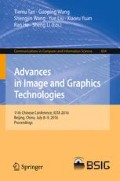Abstract
This paper proposes a general framework for the problem of structured sparsity via half-quadratic (HQ) minimization. Based on the theory of convex conjugacy, we firstly define an \(l_{2,1}^\varepsilon \)-norm and induce a family of penalty functions for structured sparsity. Then we build and discuss some important properties of these functions. By introducing the multiplicative auxiliary variable in HQ, we further reformulate the structured sparsity problem as an augmented half-quadratic optimization problem, and propose a general iteratively reweighted framework to alternately minimize the cost function. The proposed framework can be used in sparse representation, group sparse representation and multi-task joint sparse representation. Finally, in terms of the task of multi-biometric information fusion, we apply our proposed methods to obtain a novel fusion strategy, named structured fusion. Experimental results on the multi-biometric problems corroborate our claims and validate the proposed methods.
Access this chapter
Tax calculation will be finalised at checkout
Purchases are for personal use only
References
Bach, F.R.: Consistency of the group lasso and multiple kernel learning. J. Mach. Learn. Res. 9, 1179–1225 (2008)
Boyd, S., Vandenberghe, L.: Convex Optimization. Cambridge University Press, Cambridge (2004)
Chartrand, R., Yin, W.: Iteratively reweighted algorithms for compressive sensing. In: Proceedings of the IEEE Conference on Acoustics, Speech and Signal Processing, pp. 3869–3872 (2008)
Daubechies, I., Devore, R., Fornasier, M., Gunturk, C.S.: Iteratively reweighted least squares minimization for sparse recovery. Commun. Pure Appl. Math. 63(1), 1–38 (2010)
Fornasier, M.: Theoretical Foundations and Numerical Methods for Sparse Recovery. Walter de Gruyter, Berlin (2010)
Fornasier, M., Rauhut, H., Ward, R.: Low-rank matrix recovery via iteratively reweighted least squares minimization. SIAM J. Optim. 21(4), 1614–1640 (2011)
He, R., Sun, Z., Tan, T., Zheng, W.-S.: Recovery of corrupted low-rank matrices via half-quadratic based nonconvex minimization. In: Proceedings of the IEEE Conference on Computer Vision and Pattern Recognition, pp. 2889–2896 (2011)
He, R., Zheng, W.S., Hu, B.G.: Maximum correntropy criterion for robust face recognition. IEEE Trans. Pattern Anal. Mach. Intell. 33(8), 1561–1576 (2011)
Jenatton, R., Audibert, J.-Y., Bach, F.: Structured variable selection with sparsity-inducing norms. J. Mach. Learn. Res. 12, 2777–2824 (2011)
Jenatton, R., Obozinski, G., Bach, F.: Structured sparse principal component analysis. In: Proceedings of the International Conference on Artificial Intelligence and Statistics (2009)
Li, A., Shan, S., Chen, X., Gao, W.: Face recognition based on non-corresponding region matching. In: Proceedings of the IEEE International Conference on Computer Vision, pp. 1060–1067 (2011)
Moayedi, F., Azimifar, Z., Boostani, R.: Structured sparse representation for human action recognition. Neurocomputing 161, 38–46 (2015)
Morales, J., Micchelli, C.A., Pontil, M.: A family of penalty functions for structured sparsity. In: Advances in Neural Information Processing Systems, pp. 1612–1623 (2010)
Nie, F., Huang, H., Cai, X., Ding, C.: Efficient and robust feature selection via joint \(l_{2,1}\)-norms minimization. In: Advances in Neural Information Processing Systems, pp. 1813–1821 (2010)
Nikolova, M., Ng, M.K.: Analysis of half-quadratic minimization methods for signal and image recovery. SIAM J. Sci. Comput. 27(3), 937–966 (2005)
Pillai, J.K., Patel, V.M., Chellappa, R., Ratha, N.K.: Secure and robust iris recognition using random projections and sparse representations. IEEE Trans. Pattern Anal. Mach. Intell. 33(9), 1877–1893 (2011)
Suk, H.-I., Wee, C.-Y., Lee, S.-W., Shen, D.: Supervised discriminative group sparse representation for mild cognitive impairment diagnosis. Neuroinformatics 13(3), 277–295 (2015)
Sun, Y., Wang, X., Tang, X.: Deeply learned face representations are sparse, selective, and robust. In: Proceedings of the IEEE Conference on Computer Vision and Pattern Recognition, pp. 2892–2900 (2015)
Wang, L., Pan, C.: Visual tracking via manifold regularized local structured sparse representation model. In: IEEE International Conference on Image Processing, pp. 1150–1154 (2015)
Wipf, D., Nagarajan, S.: Iterative reweighted \(l_1\) and \(l_2\) methods for finding sparse solutions. IEEE J. Sel. Top. Signal Process. 4(2), 317–329 (2010)
Wright, J., Ma, Y., Mairal, J., Sapiro, G., Huang, T.S., Yan, S.: Sparse representation for computer vision and pattern recognition. Proc. IEEE 98(6), 1031–1044 (2010)
Yang, M., Zhang, L., Yang, J., Zhang, D.: Robust sparse coding for face recognition. In: Proceedings of the IEEE Conference on Computer Vision and Pattern Recognition, pp. 625–632 (2011)
Yuan, X., Liu, X., Yan, S.: Visual classification with multitask joint sparse representation. IEEE Trans. Image Process. 21, 4349–4360 (2012)
Zhang, H., Nasrabadi, N.M., Zhang, Y., Huang, T.S.: Joint dynamic sparse representation for multi-view face recognition. Pattern Recogn. 45(4), 1290–1298 (2012)
Zhang, Z.: Parameter estimation techniques: a tutorial with application to conic fitting. Image Vis. Comput. 15(1), 59–76 (1997)
Author information
Authors and Affiliations
Corresponding author
Editor information
Editors and Affiliations
Rights and permissions
Copyright information
© 2016 Springer Science+Business Media Singapore
About this paper
Cite this paper
Wei, J., Li, Z., Cao, D., Zhang, M., Zeng, C. (2016). Structured Sparsity via Half-Quadratic Minimization. In: Tan, T., et al. Advances in Image and Graphics Technologies. IGTA 2016. Communications in Computer and Information Science, vol 634. Springer, Singapore. https://doi.org/10.1007/978-981-10-2260-9_16
Download citation
DOI: https://doi.org/10.1007/978-981-10-2260-9_16
Published:
Publisher Name: Springer, Singapore
Print ISBN: 978-981-10-2259-3
Online ISBN: 978-981-10-2260-9
eBook Packages: Computer ScienceComputer Science (R0)

